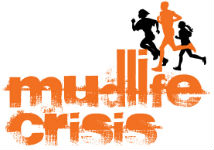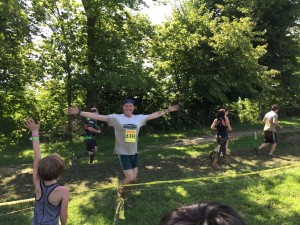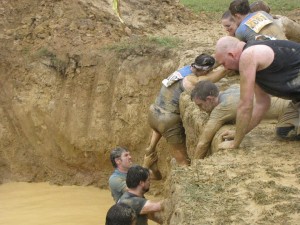It’s the New Year, and people are making decisions about which OCR races to run this season, their goals, and planning for training and the like. And when you’re making those decisions, one of the most important things to think about is the level at which you want to participate. And I’m not talking distance, or difficulty of obstacles, or things like that. I’m talking about how you want to approach the race you’re in and whether you want to try it competitively or as part of a team.
It really depends on your goals. I’ve run races both ways – as a team member and individually for time. And no matter which way you do it, you’ll get something out of it.
Timed OCR Races
Let’s look at the obvious one, first: running a race competitively. When I say competitively, I’m talking about running the race with a timing chip and being more quantitative in how you approach the race. This obviously appeals to more competitive people, who want to test themselves against others and see how they stack up.
Almost all obstacle course races (OCRs) have a timed option (Tough Mudder being the biggest exception in this regard). It generally costs a bit more as you’re paying for a timing chip on your shoe or race bib, but it’s usually not too much more. Also, the timed waves generally run a bit earlier than other waves. As the day goes on the race courses tend to get more sloppy and hard to negotiate, so most of the folks who are concerned about time try to get in as early as possible. It is possible in most cases to get a timing chip and run later, but it’s not as common.
Depending on the race, you’ll also be more likely to be running against professional and semi-pro racers – those with sponsorships and the like. They have those sponsorships and status for a reason: they’re pretty darned good. Being around that level of fitness is really motivational to a lot of people.
I’ll be perfectly honest: a big part of running an OCR for me is just that – to see how I stack up against my fellow human beings, especially those in my age range. I get a kick out of being able to do things other people can’t or won’t do, doing things that are out of the ordinary, and then gauging my fitness and ability against those kinds of results. I also like comparing my results to younger folks and seeing how many of them I am holding my own with – as an indicator of how much I’ve “turned back the clock.”
One of the most memorable races I ever ran was my first Mud Ninja race. I’d recently run the Warrior Dash race and done pretty well and without too much of a problem, so I decided to try out a timed race at Mud Ninja and add an additional challenge: doing what was then called the “Maniac Mud Ninja” option, where they give you extra weight to carry with you. In this case it was 16 pounds, and a few days before the race they sent out a notification to the “Maniac” entrants that described what you needed to bring to carry this weight. In this case, it was two gallons of water in plastic jugs (taped shut to avoid leaking, obviously). So I ran the whole thing with two full gallon jugs in a backpack. It was hard, hot, miserable, exhausting, and I loved every moment of it. The Maniac finishers got a special medal with a yellow ribbon, and walking around the race festival grounds afterward and seeing a few other folks with that medal was awesome as you’d silently give each other a nod or a thumbs up and have a great time talking about which obstacles were harder because of the weight, etc. It was really fantastic to experience that level of “I did it” and share it with other people.
The possible downside: if you’re not willing to ask for help from people you don’t know, you might have more obstacle fails.
Team OCR races
That being said, the other option for running the races is to do it as part of a team. Unless you’re in an event with a team medal, which there aren’t many of, it doesn’t really make sense to be timed in a team race. This is more about getting out and having a fun day challenging yourself with your friends. And let me tell you, it can be just as rewarding to do it this way if you’re not a competitive person. Or, even if you are.
The year after my Maniac Mud Ninja experience, my wife and I recruited a team of friends to join us. A couple of the team members had run as individuals the previous year as I did, but mostly they were OCR virgins. We got together a few times to work out together with one of our team members who is also a personal trainer and movement gym owner (Lori Crock of Movestrong Kettlebells) who trained us in MovNat techniques and created workout challenges for us to improve our fitness, our obstacle skill, and our camaraderie.
The entire experience was a blast. We got into great shape, got to know each other more, worked with each other and supported each other through the whole experience, and when it came time to run the race we were encouraging each other, laughing, sliding in the mud, comparing mud stains and mud carrying capacity, and crossed the finish line as a team. I’m still friends with everyone on the team, and though we haven’t run an event together since that time, we remain in touch and haven’t ruled out doing it again! (I chronicled this on another post).
This is a great option for those who just want the experience of trying something new, testing your boundaries, and enjoying a fantastic day doing something with great people. If you’re running Tough Mudder, it’s the best way to do it – with no timing, the challenge there is to get everyone on your team (and in your wave) through the course. Doing a Tough Mudder alone is possible, but not nearly as much fun! And for all the races like this, it doesn’t matter much whether you run early or late, you’re just doing it to have a good time while challenging yourself.
However, if you are more competitive, it could possibly be frustrating to be held up by teammates. Your results may vary.
Both?
Now, you can run timed and as a team. There’s nothing wrong with that, obviously. It’s a little trickier, unless the race you’re in has a team competition (which a few do have). You have built-in help for the obstacles that require it, but you may get delayed if something happens to a teammate – you’re not reliant entirely upon yourself and no one else. So that’s something to keep in mind.
So which experience sounds better for you? Have you tried running both ways? What did you think? Hope you’ll comment below!








